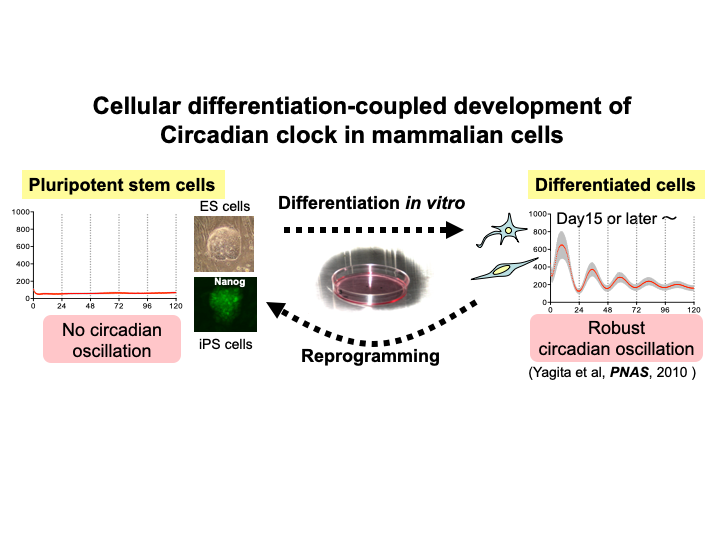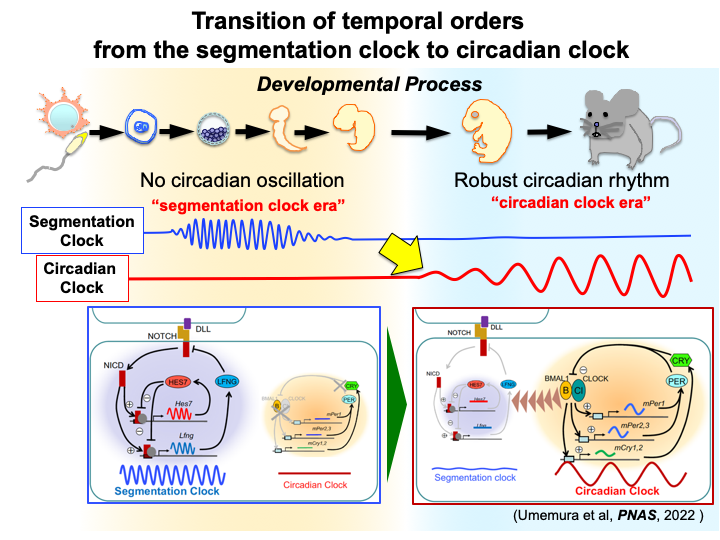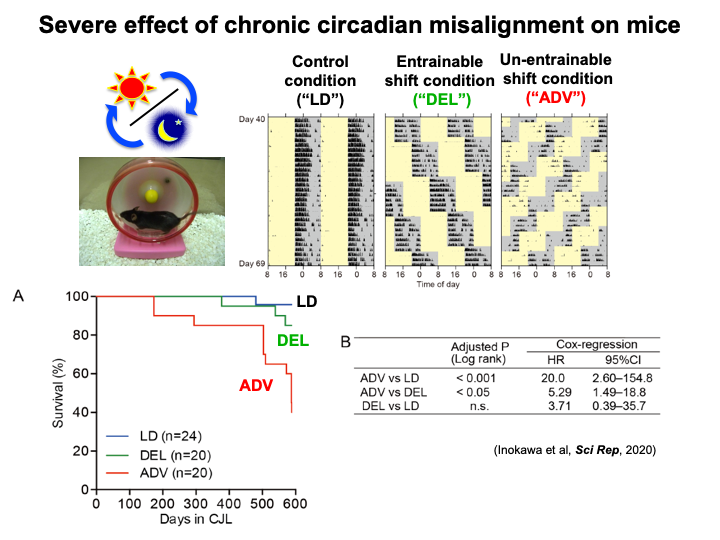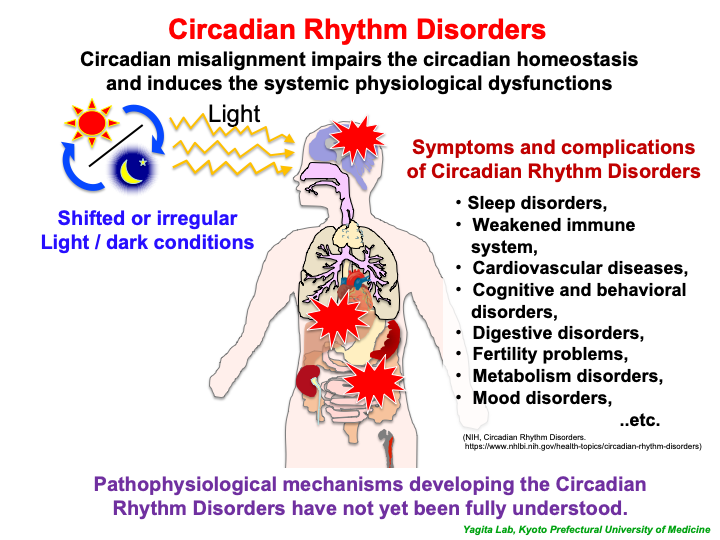Department of Physiology & Systems Bioscience
Principles to Human Physiology
〜From the
principles of circadian rhythms to human physiology and pathology〜
Living organisms have evolved a circadian clock as an adaptation mechanism to the
diurnal variation of day and night caused by the rotation of the Earth, which is the
most fundamental environmental change. By assimilating the geophysical frequency of the
Earth into the intrinsic biological processes through the circadian clock, organisms are
able to maintain orderly alternation of biochemical reactions and physiologies to
achieve biological homeostasis.
We are primarily interested in the fundamental basis of Circadian Rhythms in humans and all living organisms. Discrepancy between environmental time and the body clock is known to disrupt circadian rhythms and affect our health in various ways. The study of emergence, maintenance, and misalignment of circadian rhythms will unveil the mechanisms of disease development caused by environmental factors prevalent in our 24/7 modern societies. We aim to elucidate the basic principles of chronobiology and solve real-world problems associated with dysregulated circadian rhythms.
We are primarily interested in the fundamental basis of Circadian Rhythms in humans and all living organisms. Discrepancy between environmental time and the body clock is known to disrupt circadian rhythms and affect our health in various ways. The study of emergence, maintenance, and misalignment of circadian rhythms will unveil the mechanisms of disease development caused by environmental factors prevalent in our 24/7 modern societies. We aim to elucidate the basic principles of chronobiology and solve real-world problems associated with dysregulated circadian rhythms.
01Biological clock and circadian rhythm
The body clock is a biological device that measures the earth's 24-hr rotation
cycle, anticipates dawn and dusk, and adapts to environmental changes by
actively adjusting biological functions in advance. In other words, the role of
the biological clock, also called the circadian clock, is to harmonize the
body's functions with the environmental changes caused by the Earth's rotation.
For example, in humans, the biological clock controls not only the sleep cycle,
but also myriad organ systems including the autonomic nervous system, the
endocrine system, the cardiovascular system, the digestive system, the immune
system, and many others so that they work at their optimal timing. The diurnal
rhythm of these physiological functions is called the "circadian rhythm”. In our
laboratory, we are studying the basis of the circadian clock as an
"informational mechanism of time" that assimilates the laws of motion of the
earth (the laws of the universe!) into the body and adapts various biological
functions to the environmental cycle. What does this internal clock mean to
living organisms?
We have recently illuminated that the biological clock is not present in pluripotent stem cells such as ES cells and iPS cells, but emerges in conjunction with the development and cell differentiation (PNAS, 2010). In addition, we also found that the formation of the biological clock is accompanied by synchronous adaptation to the environmental rhythms of the outside world (maternal rhythms) (PNAS, 2017). These findings suggest that the circadian clock interface the external environment and the internal physiology, creating an operational time order in the body in relation to the environment. Interestingly, we further discovered the transition of two different types of rhythms during the developmental process, from the segmentation clock to the circadian clock (PNAS, 2022). During somitogenesis, circadian clock-mediated 24-hour temporal order is suppressed to avoid interfere with the segmentation clock. Building on these recent findings, our current goal is to elucidate the principle of circadian rhythms and the control mechanism of homeodynamics that permeates the hierarchy of molecular, cellular, tissue, organ, and individual levels.
We have recently illuminated that the biological clock is not present in pluripotent stem cells such as ES cells and iPS cells, but emerges in conjunction with the development and cell differentiation (PNAS, 2010). In addition, we also found that the formation of the biological clock is accompanied by synchronous adaptation to the environmental rhythms of the outside world (maternal rhythms) (PNAS, 2017). These findings suggest that the circadian clock interface the external environment and the internal physiology, creating an operational time order in the body in relation to the environment. Interestingly, we further discovered the transition of two different types of rhythms during the developmental process, from the segmentation clock to the circadian clock (PNAS, 2022). During somitogenesis, circadian clock-mediated 24-hour temporal order is suppressed to avoid interfere with the segmentation clock. Building on these recent findings, our current goal is to elucidate the principle of circadian rhythms and the control mechanism of homeodynamics that permeates the hierarchy of molecular, cellular, tissue, organ, and individual levels.


02Circadian rhythm disorder as pre-symptomatic disease
In recent years, globalization and technological advances have led to a
pervasive 24-hr urban lifestyle. The number of shift workers, including those
who work late at night, continues to increase, and it is estimated that more
than 12 million people in Japan are engaged in such work. In addition, with
cities abundantly lit even in the middle of the night, and the spread of
smartphones and tablets, lifestyle perturbations are affecting everyone,
including children. In such a modern society, the discrepancy between the
"biological clock," which originally co-evolved with the Earth's rotation cycle,
and the modern daily routine in our life is leading to various health problems
and increased risk of diseases.
Since shift workers are indispensable for our society, the pressing challenge is to understand how exactly the environmental factors, such as deviations in lifestyle and body clocks, affect physiological functions and alter molecular and cellular mechanisms. The mechanism of homeostasis disruption due to environmental challenges is largely unclear, partly due to the significant barrier of individual differences. Recently, we succeeded in developing a new approach named "mouse cohort model" to deduce the progressive process of circadian disorders. We showed that circadian misalignment mimicking the shift work resulted in profound deleterious consequences in mice, leading to disrupted homeostasis and abbreviated lifespan (Sci Rep, 2020). We are now working to answer the question of how environmental perturbation initiates the sequence of events leading to circadian disorders.
Since shift workers are indispensable for our society, the pressing challenge is to understand how exactly the environmental factors, such as deviations in lifestyle and body clocks, affect physiological functions and alter molecular and cellular mechanisms. The mechanism of homeostasis disruption due to environmental challenges is largely unclear, partly due to the significant barrier of individual differences. Recently, we succeeded in developing a new approach named "mouse cohort model" to deduce the progressive process of circadian disorders. We showed that circadian misalignment mimicking the shift work resulted in profound deleterious consequences in mice, leading to disrupted homeostasis and abbreviated lifespan (Sci Rep, 2020). We are now working to answer the question of how environmental perturbation initiates the sequence of events leading to circadian disorders.

03Human circadian physiology: From Lab to Society
In our laboratory, we are also developing "human physiology" research by
elucidating and applying the principles of "environmental adaptation,"
"pre-symptomatic state," and "individual differences."

Publication List (Selected)
1
Umemura Y, Koike N, Tsuchiya Y, Watanabe H, Kondoh G, Kageyama R, Yagita
K*., Circadian key components CLOCK/BMAL1 interferes with segmentation clock in mouse
embryonic organoids., Proc. Natl. Acad. Sci. USA, 119, e2114083119,
2022(*Corresponding author)
2
Inokawa H, Umemura Y, Shimba A, Kawakami E, Koike N, Tsuchiya Y, Ohashi M, Minami Y, Cui G, Asahi T,
Ono R, Sasawaki Y, Konishi E, Yoo S-H, Chen Z, Teramukai S, Ikuta K and Yagita
K*., Chronic circadian misalignment accelerates immune senescence and abbreviates
lifespan in mice., Sci. Rep.,10, 2569, 2020 (*Corresponding author)
3
Umemura Y, Maki I, Tshuchiya Y, Koike N, Yagita K*., Human circadian molecular oscillation
development using induced pluripotent stem cells, J Biol Rhythm , 34,
525-532, 2019(*Corresponding author)
4
Ikeda R, Tsuchiya Y, Koike N, Umemura Y, Inokawa H, Ono R, Inoue M, Sasawaki Y, Grieten T, Okubo N,
Ikoma K, Fujiwara H, Kubo T, Yagita K*. REV-ERBa and REV-ERBb function as
key factors regulating Mammalian Circadian Output., Sci. Rep., 9, 10171,
2019 (*Corresponding author)
5
Ohashi M, Umemura Y, Koike N, Tsuchiya Y, Inada Y, Watanabe H, Tanaka T, Minami Y, Ukimura O, Miki
T, Tajiri T, Kondoh G, Yamada Y, Yagita K*., Disruption of circadian
clockwork in in vivo reprogramming-induced mouse kidney tumors., Genes
Cells, 23, 60-69, doi: 10.1111/gtc.12552., 2018 (*Corresponding author)
6
Umemura Y, Koike N, Ohashi M, Tsuchiya Y, Meng QJ, Minami Y, Hara M, Inokawa H, Hisatomi M, Yagita K*., Involvemant of post-transcriptional regulation of Clock in the
emergence of circadian clock oscillation during mouse development., Proc. Natl.
Acad. Sci. USA, 114, E7479-7488, 2017 (*Corresponding author)
7
Kunimoto T, Okubo N, Minami Y, Fujiwara H, Hosokawa T, Asada M, Oda R, Kubo T, Yagita K*., A PTH-responsive circadian clock operates in ex vivo mouse femur
fracture healing site., Sci. Rep., 6, 22409, 2016 (*Corresponding author)
8
Tsuchiya Y, Umemura Y, Minami Y, Koike N, Hosokawa T, Hara M, Ito H, Inokawa H, Yagita K*., Effect of Multiple Clock Gene Ablations on the Circadian
Period-Length and Temperature Compensation in Mammalian Cells., J. Biol.
Rhythm, 31, 48-56, 2016 (*Corresponding author)
9
Umemura Y, Koike N, Matsumoto T, Yoo S-H, Zhen C, Yasuhara N, Takahashi JS, Yagita K*., Transcriptional Program of Kpna2 /Importin-α2 Regulates Cellular
Differentiation-Coupled Circadian Clock Development in Mammalian Cell, Proc.
Natl. Acad. Sci. USA, 111, E5039-48, 2014 (*Corresponding author)
10
Sumiyama K, Kawakami K, Yagita K. A Simple and highly efficient
transgenesis method in mice with the Tol2 transposon system and cytoplasmic microinjection., Genomics, 95, 306-311, 2010.
11
Yagita K*, Horie K, Koinuma S, Nakamura W, Yamanaka I, Urasaki A,
Shigeyoshi Y, Kawakami K, Shimada S, Takeda J, Uchiyama Y, Development of circadian oscillator
during differentiation of mouse embryonic stem cell in vitro., Proc. Natl. Acad.
Sci. USA, 107, 3846-3851, 2010. (* Corresponding author)
12
Kiyohara, Y#, Nishii K#, Ukai-Tadenuma M, Ueda HR, Uchiyama Y, Yagita K*.
Detection of a circadian enhancer in the mDbp promoter using prokaryotic transposon vector based
strategy., Nucl. Acids Res., 36, e23, 2008. (*Corresponding Author)
13
13. Kiyohara Y.B#, Tagao S#, Tamanini F, Morita A, Sugisawa Y, Yasuda M, Yamanaka I, Ueda H.R, van
der Horst GTJ, Kondo T, and Yagita K*. The BMAL1 C terminus regulates the
circadian transcription feedback loop. Proc. Natl. Acad. Sci. USA, 103,
10074-9, 2006. (*Corresponding Author)
14
Yagita K, Tamanini F, van Der Horst GT, Okamura H. Molecular mechanisms of
the biological clock in cultured fibroblasts., Science., 292:278-81. 2001
